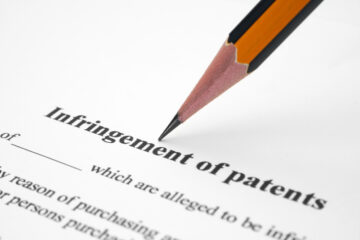
Building and improving upon the strength of the US patent system is integral to innovation and economic growth. Entrepreneurs and companies seeking to receive, assert, or defend a patent depend on transparent and consistent patent granting and enforcement systems. A patent system that is both nimble and predictable incentivizes innovation and investment in new technology.
When it was implemented in 2012, the Patent Trial and Appeal Board (PTAB) came with much fanfare. Both patent holders and patent examiners hailed it as an alternative to the prohibitively large volume of patent cases heard in district courts annually. In a given year, the PTAB hears 12,000 appeals and conducts 1,500 trial proceedings that would otherwise be bogged down in traditional courts, or simply never heard.
As the successor to the Board of Patent Appeals and Interferences, the promise of the PTAB was an easier, fairer path for patent holders and other patent stakeholders to rapidly adjudicate issues including patent awards, post-grant patentability (patent validity), and appeals.
So why then, despite its hundreds of qualified judges and bipartisan support, has PTAB become an ineffective body abused by stakeholders? While it’s still capable of expediting sound legal rulings, PTAB is commonly used to uphold low-quality patents and stamp out the competition while acting as a magnet for bad-faith actors.
Politics and Misuse of Power at PTAB
The structure of the PTAB includes both statutory members (appointed by the executive branch) and administrative judges (APJs), with the former with discretion over the latter in some cases. APJs are held to high standards and are qualified to make decisions in the cases they rule on. APJs come from highly specialized backgrounds and have the necessary technical, industry, and legal knowledge. Statutory members, on the other hand, have no defined qualifications described in the legislation that established the PTAB, the America Invents Act (AIA). Their role as political appointees makes them susceptible to outside influence.
A recent report published by the Governmental Accountability Office shows that both current and former judges have felt a lack of autonomy while serving the PATB. Statutory members are able to, subtly and not-so-subtly, influence APJ decisions, even in intre parte cases where they are barred from doing so. These decisions include the outright overturning of dually-reached rulings or simply timing the release of relevant information in a way that affects judges’ decisions. The end result is a process that purports to be independent, but is, frankly, not.
Litigiousness and Misaligned Incentives
Companies have used the PTAB to harass and stall competitors to the detriment of entrepreneurial firms. One notable 2019 case involving VLSI Technology LLC and Intel demonstrates this to great effect.
An initial $2.1 billion judgment was made in district court to compensate VLSI for infringement by Intel. Shortly after, two companies (OpenSky Industries and Patent Quality Assurance) were quickly formed to level inter partes review (IPR) cases against VLSI. Neither OpenSky nor Patent Quality Assurance owns or sells any technology. OpenSky was able to use the PTAB as a pretense to leveling infringement claims against both VLSI and Intel, hoping that one or the other would pay them to drop the case.
That this was such a blatant abuse of the PTAB that it attracted the attention of a director-level regulator at the USTPO, who took extraordinary action to sanction OpenSky and remove the company from the claim. But OpenSky continued to wreak havoc on the PTAB system by opening the door for Intel to resume its attack on the VLSI patents that led to its $2.1 billion infringement judgment, despite being barred from doing so by statutory limitations. The PTAB’s rules allowed Intel to effectively take over for OpenSky in its IPR claim, creating a backdoor for frivolous patent validity claims.
Big Companies Dominate the PTAB
If companies like OpenSky can spontaneously emerge to abuse PTAB, what can large corporations do to distort the process and hurt innovation? Offenders include names you recognize, and likely respect, like Apple and Samsung. While thought of as innovative companies, they are just as often concerned with protecting their own market share as developing new technology. This would be acceptable—if they weren’t relying on conflicts of interest and judicial harassment to do it.
Abuses range from former Apple patent litigators moving directly into PTAB roles to frivolous challenges to patent validity and infringement by Samsung. Under these unfair conditions, high-quality, revenue-generating patents can be quickly and decisively turned into burdens for their owners. Smaller companies see market share lost and revenue diminished, all while incurring the cost of patent litigation at the hands of market behemoths.
Perhaps PTAB was designed to be faster and less expensive, but that’s only if innovative companies aren’t unfairly dragged there repeatedly by competitors with bad intentions. Apple says it has used the board to successfully defend almost 200 patents, ostensibly to prevent suspect patent assertion entities from using low-quality patents to extract royalties. Still, the PTAB should not act as a safe haven for infringers.
The Consequences of Patent Reversals
In 2020, 84% of patents before the PTAB had some or all of their claims invalidated. Depending on the methodology, estimations of the total volume of invalidated patents range from 2,000 since 2012 to 3,000 in 2020. The incentive to innovate is harmed by this litigiousness. If entrepreneurial firms are disincentivized to develop technology or seek patent protections, they are likely to avoid doing so.
Exacerbating the problem of invalidated patents is the financial incentive to bring cases before PTAB. Chief among them is forestalling payments for infringement damages. Apple was able to first postpone fulfilling its legal duty for years with PTAB until a judge ordered them to pay an infringed-upon firm. L’Oreal did the same in 2018. While these two cases ended positively for the plaintiffs in district courts, each had to endure the loss of revenue and the cost of litigation for a time. These precedents may not apply universally, leaving the situation a precarious one for patent holders.
Constitutional Challenges
Cases that go to the heart of PTAB’s regulatory authority made it to SCOTUS in 2021. Though the creation of the PTAB judicial body was authorized by Congress, it was administered by the executive branch through the Secretary of Commerce.
To function, PTAB needs its judges to carry the full weight of the law. However, plaintiffs now argue that judges’ administrative authority extends far enough to invalidate their standing, bringing PTAB to the brink of unconstitutionality.
In the case of United States v. Anthrex, plaintiffs contend that because USPTO directors are barred from making rulings in IPR cases, judges’ authority extends beyond that which is granted by the constitution. The case resulted in a 5-4, 7-2 decision, in which the role of APJs as primary administrative reviewers was deemed unconstitutional. The court determined that their authority exceeded that which can be legally granted by the Secretary of Commerce. The courts offered a remedy, suggesting that APJs could regain their constitutional role if their tenure were revoked, but the PTAB’s legality is likely to remain in doubt.
Curious about how PTAB is impacting your technology landscape? Sort and download litigation data in InnovationQ+™ using the gavel icon.
- SEO Powered Content & PR Distribution. Get Amplified Today.
- Platoblockchain. Web3 Metaverse Intelligence. Knowledge Amplified. Access Here.
- Source: https://ip.com/blog/ptab-is-misused-by-patent-stakeholders-heres-how/
- 000
- 1
- 2012
- 2019
- 2020
- 2021
- a
- Able
- About
- abuse
- accountability
- Act
- administered
- administrative
- After
- against
- AIA
- All
- alternative
- america
- among
- and
- Annually
- appeal
- appeals
- Apple
- Apply
- appointed
- argue
- assurance
- attack
- attention
- attracted
- authority
- awards
- backdoor
- backgrounds
- Bad
- because
- become
- before
- Behemoths
- being
- Beyond
- Billion
- bipartisan
- board
- body
- bogged
- Branch
- bring
- Bringing
- brink
- capable
- carry
- case
- cases
- challenges
- chief
- claim
- claims
- come
- Commerce
- commonly
- Companies
- company
- competition
- competitors
- concerned
- conditions
- conducts
- Congress
- Consequences
- consistent
- Constitution
- continued
- Corporations
- Cost
- could
- Court
- Courts
- Creating
- creation
- Current
- data
- decision
- decisions
- Depending
- described
- designed
- Despite
- determined
- develop
- developing
- DID
- directly
- Directors
- discretion
- district
- doing
- dominate
- Door
- doubt
- down
- download
- Drop
- each
- easier
- Economic
- Economic growth
- effect
- effectively
- enforcement
- enough
- entities
- entrepreneurial
- entrepreneurs
- established
- Even
- executive
- expensive
- extract
- faster
- financial
- Firm
- firms
- First
- formed
- Former
- from
- full
- function
- GAO
- given
- Go
- governmental
- granted
- granting
- great
- Growth
- Hands
- heard
- Heart
- Held
- High
- high-quality
- highly
- holders
- hoping
- How
- However
- HTML
- HTTPS
- Hundreds
- Hurt
- ICON
- implemented
- improving
- in
- Incentive
- incentivizes
- include
- includes
- Including
- independent
- industries
- industry
- influence
- information
- infringement
- initial
- innovate
- Innovation
- innovative
- integral
- Intel
- interest
- investment
- issues
- IT
- judge
- knowledge
- Lack
- landscape
- large
- Law
- leaving
- Led
- Legal
- Legislation
- Level
- likely
- limitations
- Litigation
- LLC
- loss
- made
- make
- MAKES
- Making
- Market
- Members
- Methodology
- moving
- names
- necessary
- needs
- Neither
- New
- notable
- offered
- Office
- ONE
- opening
- Other
- otherwise
- outside
- own
- owners
- owns
- patent
- Patent Trial and Appeal Board
- Patents
- path
- Pay
- payments
- plato
- Plato Data Intelligence
- PlatoData
- political
- power
- Predictable
- prevent
- primary
- Problem
- process
- promise
- protecting
- PTAB
- qualifications
- qualified
- quality
- quickly
- range
- rapidly
- recognize
- regulator
- regulatory
- release
- relevant
- remain
- remove
- REPEATEDLY
- report
- result
- resume
- revenue
- review
- Role
- roles
- royalties
- Rule
- rules
- safe
- Safe Haven
- same
- Samsung
- Sanction
- Seek
- seeking
- Sells
- serving
- Share
- Shortly
- should
- Shows
- simply
- since
- situation
- smaller
- So
- some
- Sound
- specialized
- stakeholders
- standards
- States
- Still
- strength
- structure
- Successfully
- such
- support
- susceptible
- system
- Systems
- Take
- Technical
- Technology
- The
- the Law
- their
- thought
- Through
- time
- timing
- to
- Total
- traditional
- transparent
- trial
- Turned
- unconstitutional
- under
- Uphold
- us
- use
- USPTO
- volume
- weight
- What
- which
- while
- WHO
- would
- year
- Your
- zephyrnet










